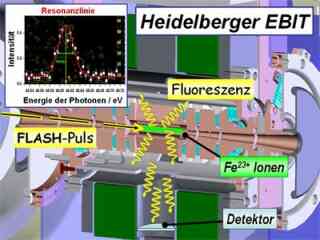X-ray laser pulses (yellow) excite the ions in the EBIT (green), which emit fluorescence radiation. The resonant fluorescence photons (yellow curved line) were measured as a function of the laser wavelength. The resonance curve is shown above. (Credit: MPG Heidelberg Press release)

Scientists from the Max Planck Institute for Nuclear Physics in Heidelberg, their collaborators from DESY and from University of Hamburg reported on the first demonstration of resonance fluorescence laser spectroscopy by matching soft X-rays from the free electron laser FLASH at DESY together with highly charged ions (HCI) provided in an electron beam ion trap (EBIT).
They investigated the transition between the 1s22s 2S1/2 (ground) and 1s22p 2P1/2 (excited) states of Li-like iron Fe23+ ions. This transition is closely related to the Lamb shift in one-electron ions and is playing an important role in the formulation of few-electron quantum electrodynamic (QED) in strong fields.
Laser spectroscopy has been limited so far beyond the VUV region due to the lack of appropriate light sources. In particular, the atomic structure of heavier, simple few-electron systems were not accessible for this precision method. With FLASH the soft X-ray region is now widely opened to laser spectroscopy. (...Annual report)
Their results appeared in Physical Review Letters (May 1, 2007).
| Further Links |
|





